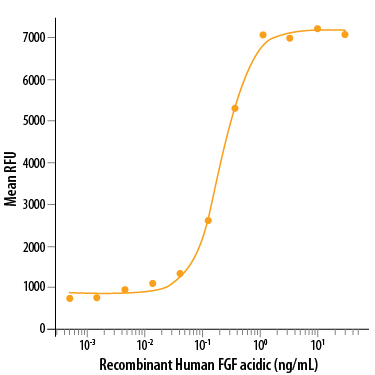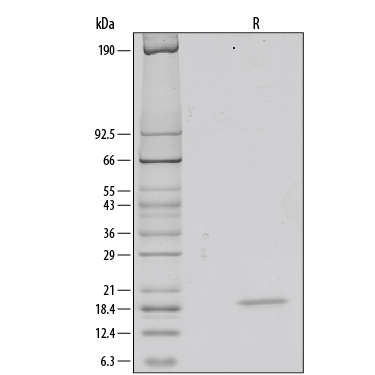Recombinant Human FGF acidic/FGF1 (aa 2-155) Protein
Recombinant Human FGF acidic/FGF1 (aa 2-155) Protein Summary
Product Specifications
Ala2-Asp155
Analysis
Product Datasheets
Carrier Free
CF stands for Carrier Free (CF). We typically add Bovine Serum Albumin (BSA) as a carrier protein to our recombinant proteins. Adding a carrier protein enhances protein stability, increases shelf-life, and allows the recombinant protein to be stored at a more dilute concentration. The carrier free version does not contain BSA.
In general, we advise purchasing the recombinant protein with BSA for use in cell or tissue culture, or as an ELISA standard. In contrast, the carrier free protein is recommended for applications, in which the presence of BSA could interfere.
231-BC
| Formulation | Lyophilized from a 0.2 μm filtered solution in MOPS, Na2SO4, TCEP and EDTA with BSA as a carrier protein. |
| Reconstitution | Reconstitute at 10 μg/mL in sterile PBS containing at least 0.1% human or bovine serum albumin. |
| Shipping | The product is shipped at ambient temperature. Upon receipt, store it immediately at the temperature recommended below. |
| Stability & Storage: | Use a manual defrost freezer and avoid repeated freeze-thaw cycles.
|
231-BC/CF
| Formulation | Lyophilized from a 0.2 μm filtered solution in MOPS, Na2SO4, TCEP and EDTA. |
| Reconstitution | Reconstitute at 100 μg/mL in sterile PBS. |
| Shipping | The product is shipped at ambient temperature. Upon receipt, store it immediately at the temperature recommended below. |
| Stability & Storage: | Use a manual defrost freezer and avoid repeated freeze-thaw cycles.
|
Scientific Data
 View Larger
View Larger
Recombinant Human FGF acidic/FGF1 (aa 2-155) (Catalog # 231-BC) stimulates cell proliferation of the NR6R‑3T3 mouse fibroblast cell line. The ED50 for this effect is 0.015-0.15 ng/mL in the presence of 10 μg/mL of heparin.
 View Larger
View Larger
1 μg/lane of Recombinant Human FGF acidic/FGF1 (aa 2-155) was resolved with SDS-PAGE under reducing (R) conditions and visualized by silver staining, showing a single band at 19 kDa.
Reconstitution Calculator
Background: FGF acidic/FGF1
FGF acidic, also known as FGF1, ECGF, and HBGF-1, is a 17 kDa nonglycosylated member of the FGF family of mitogenic peptides. FGF acidic, which is produced by multiple cell types, stimulates the proliferation of all cells of mesodermal origin and many cells of neuroectodermal, ectodermal, and endodermal origin. It plays a number of roles in development, regeneration, and angiogenesis (1-3). Human FGF acidic shares 54% amino acid (aa) sequence identity with FGF basic and 17%-33% with other human FGFs. It shares 92%, 96%, 96%, and 96% aa sequence identity with bovine, mouse, porcine, and rat FGF acidic, respectively, and exhibits considerable species crossreactivity. Alternate splicing generates a truncated isoform of human FGF acidic that consists of the N-terminal 40% of the molecule and functions as a receptor antagonist (4). During its nonclassical secretion, FGF acidic associates with S100A13, copper ions, and the C2A domain of synaptotagmin 1 (5). It is released extracellularly as a disulfide-linked homodimer and is stored in complex with extracellular heparan sulfate (6). The ability of heparan sulfate to bind FGF acidic is determined by its pattern of sulfation, and alterations in this pattern during embryognesis thereby regulate FGF acidic bioactivity (7). The association of FGF acidic with heparan sulfate is a prerequisite for its subsequent interaction with FGF receptors (8, 9). Ligation triggers receptor dimerization, transphosphorylation, and internalization of receptor/FGF complexes (10). Internalized FGF acidic can translocate to the cytosol with the assistance of Hsp90 and then migrate to the nucleus by means of its two nuclear localization signals (11-13). The phosphorylation of FGF acidic by nuclear PKC delta triggers its active export to the cytosol where it is dephosphorylated and degraded (14, 15). Intracellular FGF acidic functions as a survival factor by inhibiting p53 activity and proapoptotic signaling (16).
- Jaye, M. et al. (1986) Science 233:541.
- Galzie, Z. et al. (1997) Biochem. Cell Biol. 75:669.
- Presta, M. et al. (2005) Cytokine Growth Factor Rev. 16:159.
- Yu, Y.L. et al. (1992) J. Exp. Med. 175:1073.
- Rajalingam, D. et al. (2007) Biochemistry 46:9225.
- Guerrini, M. et al. (2007) Curr. Pharm. Des. 13:2045.
- Allen, B.L. and A.C. Rapraeger (2003) J. Cell Biol. 163:637.
- Robinson, C.J. et al. (2005) J. Biol. Chem. 280:42274.
- Mohammadi, M. et al. (2005) Cytokine Growth Factor Rev. 16:107.
- Wiedlocha, A. and V. Sorensen (2004) Curr. Top. Microbiol. Immunol. 286:45.
- Wesche, J. et al. (2006) J. Biol. Chem. 281:11405.
- Imamura, T. et al. (1990) Science 249:1567.
- Wesche, J. et al. (2005) Biochemistry 44:6071.
- Wiedlocha, A. et al. (2005) Mol. Biol. Cell 16:794.
- Nilsen, T. et al. (2007) J. Biol. Chem. 282:26245.
- Bouleau, S. et al. (2005) Oncogene 24:7839.
Citations for Recombinant Human FGF acidic/FGF1 (aa 2-155) Protein
R&D Systems personnel manually curate a database that contains references using R&D Systems products. The data collected includes not only links to publications in PubMed, but also provides information about sample types, species, and experimental conditions.
6
Citations: Showing 1 - 6
Filter your results:
Filter by:
-
Expansion of Human iPSC-Derived Ureteric Bud Organoids with Repeated Branching Potential
Authors: SI Mae, M Ryosaka, S Sakamoto, K Matsuse, A Nozaki, M Igami, R Kabai, A Watanabe, K Osafune
Cell Rep, 2020-07-28;32(4):107963.
Species: Human
Sample Types: Whole Cells
Applications: Bioassay -
Gut Microbiota Modulate CD8�T Cell Responses to Influence Colitis-Associated Tumorigenesis
Authors: AI Yu, L Zhao, KA Eaton, S Ho, J Chen, S Poe, J Becker, A Gonzalez, D McKinstry, M Hasso, J Mendoza-Ca, J Whitfield, C Koumpouras, PD Schloss, EC Martens, GY Chen
Cell Rep, 2020-04-07;31(1):107471.
Species: Human
Sample Types: Whole Cells
Applications: Bioassay -
Increased FGF1-FGFRc expression in idiopathic pulmonary fibrosis.
Authors: MacKenzie B, Korfei M, Henneke I, Sibinska Z, Tian X, Hezel S, Dilai S, Wasnick R, Schneider B, Wilhelm J, El Agha E, Klepetko W, Seeger W, Schermuly R, Gunther A, Bellusci S
Respir Res, 2015-07-03;16(0):83.
Species: Human
Sample Types: Whole Cells
Applications: Bioassay -
Human marrow stromal cells downsize the stem cell fraction of lung cancers by fibroblast growth factor 10.
Authors: Kanehira M, Kikuchi T, Santoso A, Tode N, Hirano T, Ohkouchi S, Tamada T, Sugiura H, Harigae H, Ichinose M
Mol Cell Biol, 2014-05-27;34(15):2848-56.
Species: Human
Sample Types: Whole Cells
Applications: Bioassay -
Widespread potential for growth-factor-driven resistance to anticancer kinase inhibitors.
Authors: Wilson TR, Fridlyand J, Yan Y, Penuel E, Burton L, Chan E, Peng J, Lin E, Wang Y, Sosman J, Ribas A, Li J, Moffat J, Sutherlin DP, Koeppen H, Merchant M, Neve R, Settleman J
Nature, 2012-07-26;487(7408):505-9.
Species: Human
Sample Types: Whole Cells
Applications: Bioassay -
The role of type V collagen fibril as an ECM that induces the motility of glomerular endothelial cells.
Authors: Murasawa Y, Hayashi T, Wang PC
Exp. Cell Res., 2008-09-25;314(20):3638-53.
Species: Porcine
Sample Types: Whole Cells
Applications: Bioassay
FAQs
No product specific FAQs exist for this product, however you may
View all Proteins and Enzyme FAQsReviews for Recombinant Human FGF acidic/FGF1 (aa 2-155) Protein
There are currently no reviews for this product. Be the first to review Recombinant Human FGF acidic/FGF1 (aa 2-155) Protein and earn rewards!
Have you used Recombinant Human FGF acidic/FGF1 (aa 2-155) Protein?
Submit a review and receive an Amazon gift card.
$25/€18/£15/$25CAN/¥75 Yuan/¥2500 Yen for a review with an image
$10/€7/£6/$10 CAD/¥70 Yuan/¥1110 Yen for a review without an image
